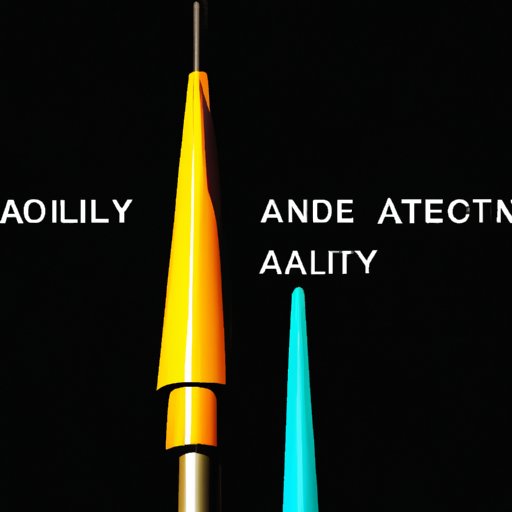Introduction
Accuracy in science is essential for producing reliable and valid results. The concept of accuracy can be defined as a measure of how close a measured value is to its true or accepted value. It is important to understand the concept of accuracy in order to ensure that scientific research is conducted correctly and accurately reported. This article will provide a comprehensive guide to accuracy in science, exploring the definition of accuracy, best practices, and the role of accuracy in scientific research.

A Comprehensive Guide to Accuracy in Science
Accuracy in science is an important concept to understand and apply when conducting research. In order to ensure accurate results, it is necessary to have an understanding of the definition of accuracy and its applications. This section will provide an overview of accuracy in science and the best practices for obtaining reliable and valid results.
Exploring the Definition
The definition of accuracy in science is the degree to which a measured value agrees with its true or accepted value. Accuracy is determined by comparing the measured value to the true value and calculating the difference between them. For example, if a researcher measures the height of a tree to be 10 meters, but the true height of the tree is actually 9.7 meters, then the accuracy of the measurement is 0.3 meters. Accuracy is often expressed as a percentage, with 100% accuracy indicating that the measured value is exactly the same as the true value.
Applications and Best Practices
In order to obtain accurate results, it is important to follow best practices when conducting scientific research. These include using the most appropriate tools and instruments, calibrating equipment regularly, and using standard protocols. Additionally, researchers should ensure that measurements are taken consistently and that any errors are documented and corrected. Finally, researchers should strive to use the most precise methods possible in order to minimize the potential for inaccurate results.
The Role of Accuracy in Scientific Research
Accuracy plays an important role in scientific research. Understanding the concept of accuracy and applying best practices is essential for obtaining reliable and valid results. This section will explore the importance of measurement precision, error analysis, and quality assurance.
Understanding Measurement Precision
Measurement precision is an important aspect of accuracy in science. Precision refers to the degree to which repeated measurements of the same quantity yield the same result. When measuring something, it is important to be as precise as possible in order to reduce the potential for error. For example, if a researcher measures the height of a tree to the nearest centimeter, they will be more likely to obtain an accurate result than if they only measure to the nearest meter.
Error Analysis and Quality Assurance
Error analysis is another important aspect of accuracy in science. Error analysis involves identifying and analyzing sources of error in order to minimize their impact on the results. Quality assurance is also important for ensuring accuracy in scientific research. Quality assurance involves verifying that procedures and protocols are followed correctly and that data is recorded and analyzed accurately.

Accuracy in Science: Exploring the Need for Reliability and Validity
Obtaining accurate results is essential for producing reliable and valid results. This section will explore the various analytical techniques and data processing strategies used to ensure accuracy in science, as well as the benefits and challenges of obtaining accurate results.
Analytical Techniques and Data Processing Strategies
There are several analytical techniques and data processing strategies that can be used to ensure accuracy in science. These include statistical analysis, data validation, and data filtering. Statistical analysis is used to identify errors and outliers in data sets. Data validation is used to verify that data is accurate and consistent. Finally, data filtering is used to remove invalid or irrelevant data from a data set.
Benefits and Challenges of Obtaining Accurate Results
Accurate results offer numerous benefits, including increased confidence in the results and improved decision-making. However, there are also some challenges associated with obtaining accurate results. These include the cost and time required to conduct research and the difficulty of obtaining reliable and valid data. Additionally, errors in data collection or analysis can lead to inaccurate results.
Conclusion
Accuracy in science is essential for obtaining reliable and valid results. This article has provided a comprehensive guide to accuracy in science, exploring the definition of accuracy, best practices, and the role of accuracy in scientific research. It has also examined the benefits and challenges of obtaining accurate results. By understanding the concept of accuracy and following best practices, researchers can ensure that their results are accurate and reliable.
Summary of Key Points
To summarize, accuracy in science is essential for obtaining reliable and valid results. The definition of accuracy is the degree to which a measured value agrees with its true or accepted value. Measurement precision, error analysis, and quality assurance are all important for ensuring accuracy in scientific research. Additionally, there are numerous analytical techniques and data processing strategies that can be used to ensure accuracy in science. Finally, obtaining accurate results offers numerous benefits, but there are also some challenges associated with obtaining accurate results.
Final Thoughts on Accuracy in Science
Accuracy in science is essential for producing reliable and valid results. By understanding the concept of accuracy and applying best practices, researchers can ensure that their results are accurate and reliable. Additionally, researchers should strive to use the most precise methods possible in order to minimize the potential for inaccurate results. Ultimately, accuracy in science is essential for conducting successful scientific research.
(Note: Is this article not meeting your expectations? Do you have knowledge or insights to share? Unlock new opportunities and expand your reach by joining our authors team. Click Registration to join us and share your expertise with our readers.)
